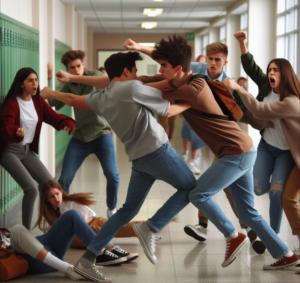School administrators and school safety professionals are seeing a noticeable increase in fighting, especially at the middle and high school levels, in the past two school years. Some fights are exceptionally large in number of students, highly aggressive, and at times involve persons fromoutside of the school who are not students.

We put together some thoughts on prevention and responding, recognizing that these are general observations from our decades of school security experience. Each school will need to evaluate its unique contexts and needs. We hope these
thoughts may be helpful in stimulating critical strategic thinking and internal conversations by school leaders, teachers, support staff, and school safety officials.
Preventing and preparing for student fights
- Take an “all in” approach and engage all staff in training and awareness about preventing and responding to student fights. Be sure all staff are trained in awareness and what to look for. This training includes custodians and food/nutrition staff. These people often are the first to see students in the morning and throughout the day.
- Engage students to identify strategies for reducing and preventing fights. What do they see as the sources of conflicts that lead to fights? What do students believe can be done to de-escalate such conflicts? How do they believe school staff can best support such prevention efforts?
- What do your school board policies and procedures state about whether staff must physically intervene? Some policies do not allow staff to physically intervene. If not allowed to physically intervene, what steps should be taken? Will police be called and who will call? Other steps?
- Staff should be assigned to known “hotspots” in the building. These times include before school, during passing periods, at breakfast and lunch, and after school. School safety leaders must ensure staff members have been trained, their duty assignments are made in writing, and leaders check that staff is in place and on time.
- Passing periods require staff to be in the hallways and visible.
- Staff must be trained to observed and what Chuck call’s “riding the range or herding the sheep.” Be on the lookout for any gathering that is out of the normal and be prepared to verbally intervene.
Responding to student fights
- Make sure everyone understands the importance of dispersing the crowd. Have you ever seen a school fight without a crowd? Without the crowd present, it is often easier to break up the fight.
- Once a fight has started, the first step for staff is to verbally intervene. Those verbal commands must be simple and direct. Call the students by name ( if you know either or any of the combatants by name). If names are not known then direct them to STOP!
- Our colleague John Weicker, retired Director of Security for Fort Wayne Community Schools (Indiana) and a former high school dean, stresses the importance of staff members identifying themselves to those that are directly and or indirectly involved in those confrontations. He notes that it is critical that students actually know who you are. He also found it very helpful that he could state to parents that he in fact had told the students exactly who he was prior to giving them those “simple and direct commands” and/or having to physically become involved in attempting to separate the combatants.
- NEVER get between combatants. This is the most common mistakes staff make and where too many staff members get injured. You are not a boxing referee!
- Repeat your verbal commands often. Often the student who is receiving the worst end of the fight is looking for someone to verbally intervene.
- Once other staff members arrive, direct them to assist you. If you must and are allowed to physically intervene, this may be the time to do so. Without another staff member to assist, this is a time when staff may be at higher risk of being injured.
Steps for after the fight
- Check each student for injuries. Get appropriate first aid or medical attention if required.
- Disperse any students who may wish to follow the combatants to the office area or where the students are being taken to debrief.
- Keep combatants separated and out of sight of each other when possible.
- Take written or recorded statements from all participants and administer discipline and related next steps according to your policies and procedures.
These are a few points to stimulate critical thinking and conversation among building administrators, teachers and support staff, and school safety teams. They are aimed at in the building fights. Fighting on school buses warrants a separate discussion. Each school will need to evaluate its unique contexts and needs.
Follow Dr. Ken on Twitter @safeschools
Visit and “Like” Our Facebook School Safety News Channel at: www.facebook.com/schoolsafety
Visit School Security Blog at: www.schoolsecurity.org/blog

